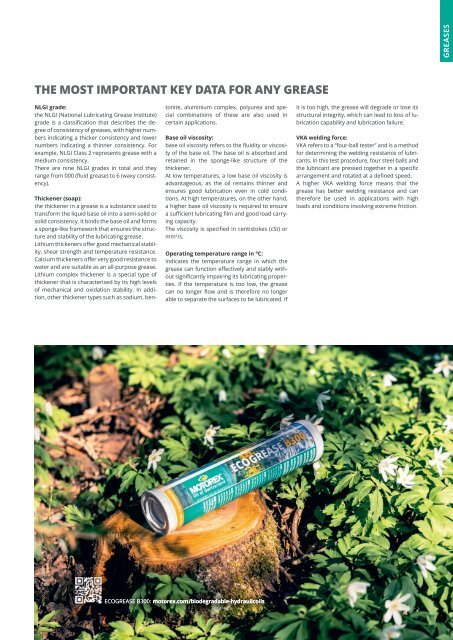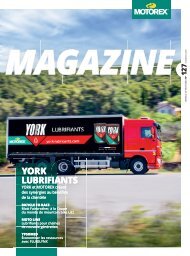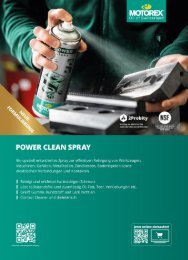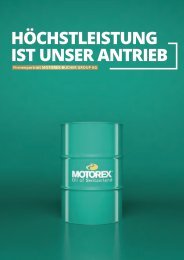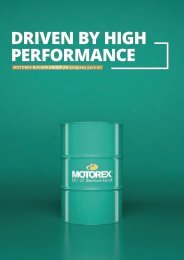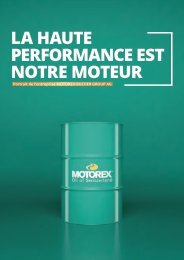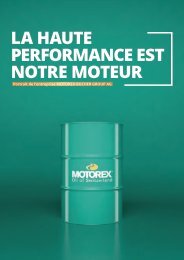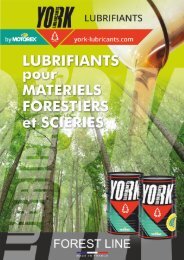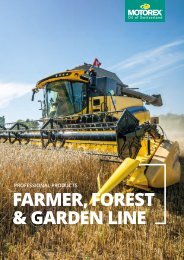TRUCK LINE BROCHURE DE FR EN 23
Create successful ePaper yourself
Turn your PDF publications into a flip-book with our unique Google optimized e-Paper software.
GREASES<br />
THE MOST IMPORTANT KEY DATA FOR ANY GREASE<br />
NLGI grade:<br />
the NLGI (National Lubricating Grease Institute)<br />
grade is a classification that describes the degree<br />
of consistency of greases, with higher numbers<br />
indicating a thicker consistency and lower<br />
numbers indicating a thinner consistency. For<br />
example, NLGI Class 2 represents grease with a<br />
medium consistency.<br />
There are nine NLGI grades in total and they<br />
range from 000 (fluid grease) to 6 (waxy consistency).<br />
Thickener (soap):<br />
the thickener in a grease is a substance used to<br />
transform the liquid base oil into a semi-solid or<br />
solid consistency. It binds the base oil and forms<br />
a sponge-like framework that ensures the structure<br />
and stability of the lubricating grease.<br />
Lithium thickeners offer good mechanical stability,<br />
shear strength and temperature resistance.<br />
Calcium thickeners offer very good resistance to<br />
water and are suitable as an all-purpose grease.<br />
Lithium complex thickener is a special type of<br />
thickener that is characterised by its high levels<br />
of mechanical and oxidation stability. In addition,<br />
other thickener types such as sodium, bentonite,<br />
aluminium complex, polyurea and special<br />
combinations of these are also used in<br />
certain applications.<br />
Base oil viscosity:<br />
base oil viscosity refers to the fluidity or viscosity<br />
of the base oil. The base oil is absorbed and<br />
retained in the sponge-like structure of the<br />
thickener.<br />
At low temperatures, a low base oil viscosity is<br />
advantageous, as the oil remains thinner and<br />
ensures good lubrication even in cold conditions.<br />
At high temperatures, on the other hand,<br />
a higher base oil viscosity is required to ensure<br />
a sufficient lubricating film and good load carrying<br />
capacity.<br />
The viscosity is specified in centistokes (cSt) or<br />
mm 2 /s.<br />
Operating temperature range in °C:<br />
indicates the temperature range in which the<br />
grease can function effectively and stably without<br />
significantly impairing its lubricating properties.<br />
If the temperature is too low, the grease<br />
can no longer flow and is therefore no longer<br />
able to separate the surfaces to be lubricated. If<br />
it is too high, the grease will degrade or lose its<br />
structural integrity, which can lead to loss of lubrication<br />
capability and lubrication failure.<br />
VKA welding force:<br />
VKA refers to a “four-ball tester” and is a method<br />
for determining the welding resistance of lubricants.<br />
In this test procedure, four steel balls and<br />
the lubricant are pressed together in a specific<br />
arrangement and rotated at a defined speed.<br />
A higher VKA welding force means that the<br />
grease has better welding resistance and can<br />
therefore be used in applications with high<br />
loads and conditions involving extreme friction.<br />
Photo: Motorex AG<br />
ECOGREASE B300: motorex.com/biodegradable-hydraulicoils<br />
MOTOREX <strong>TRUCK</strong> <strong>LINE</strong> 25


